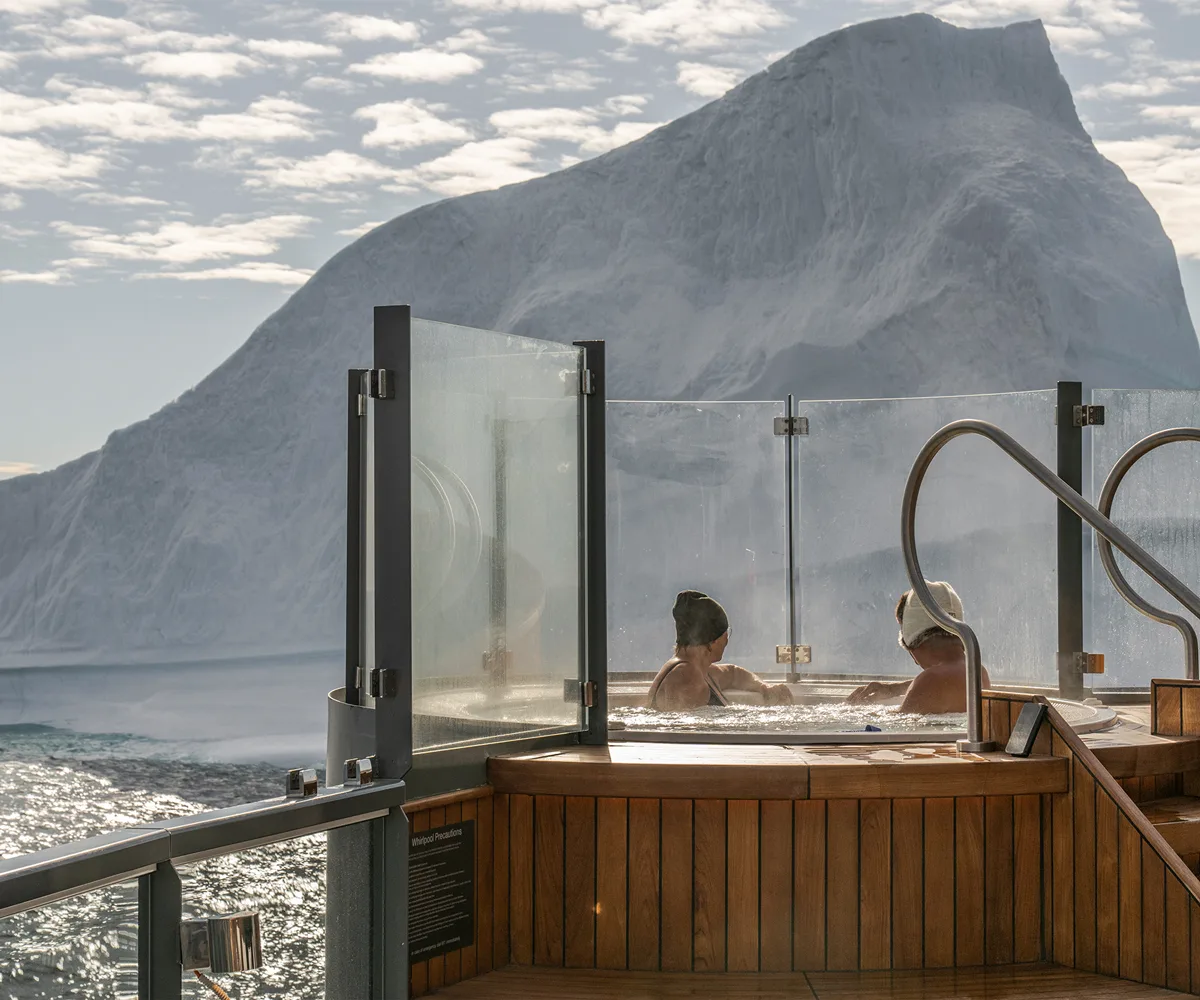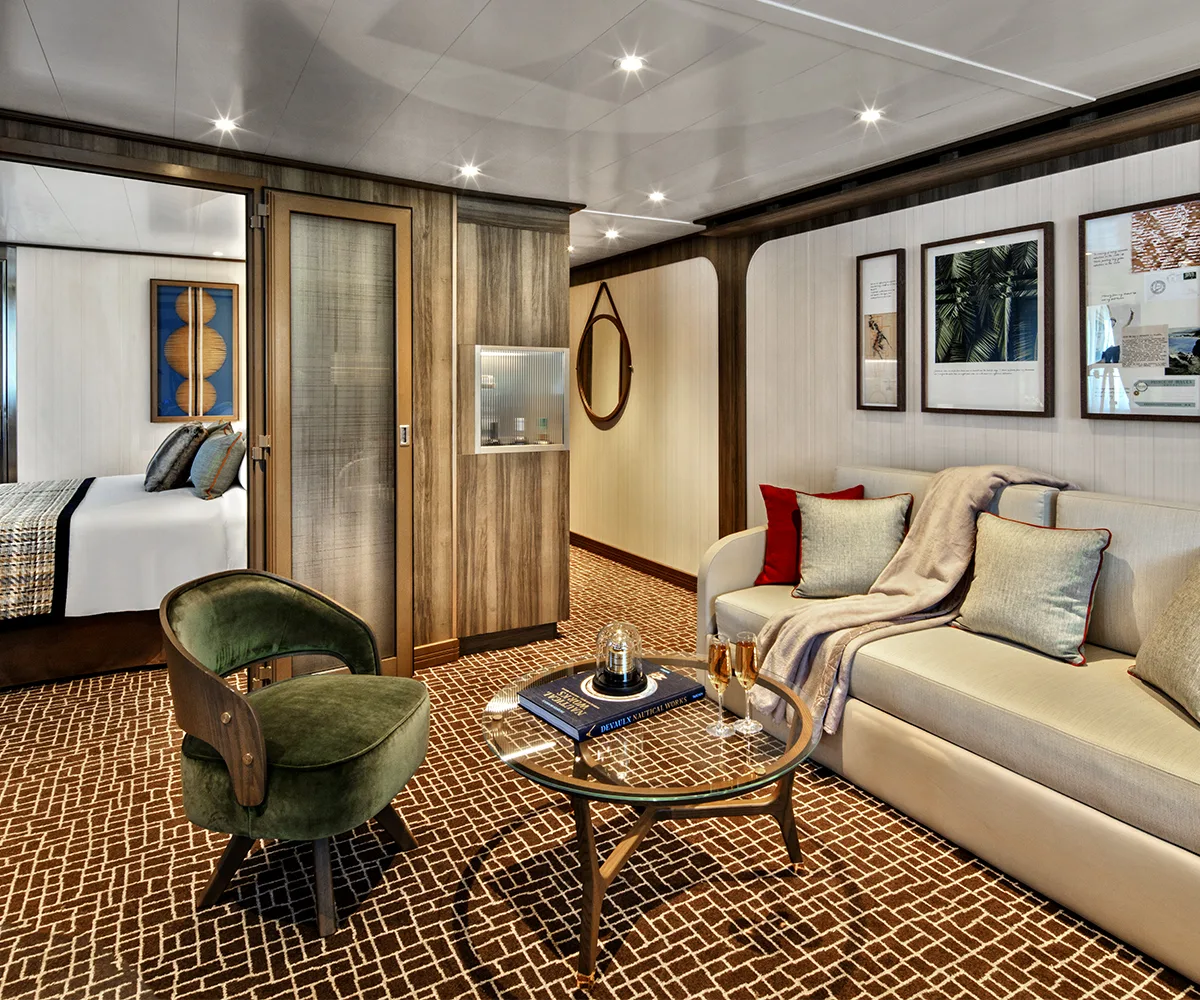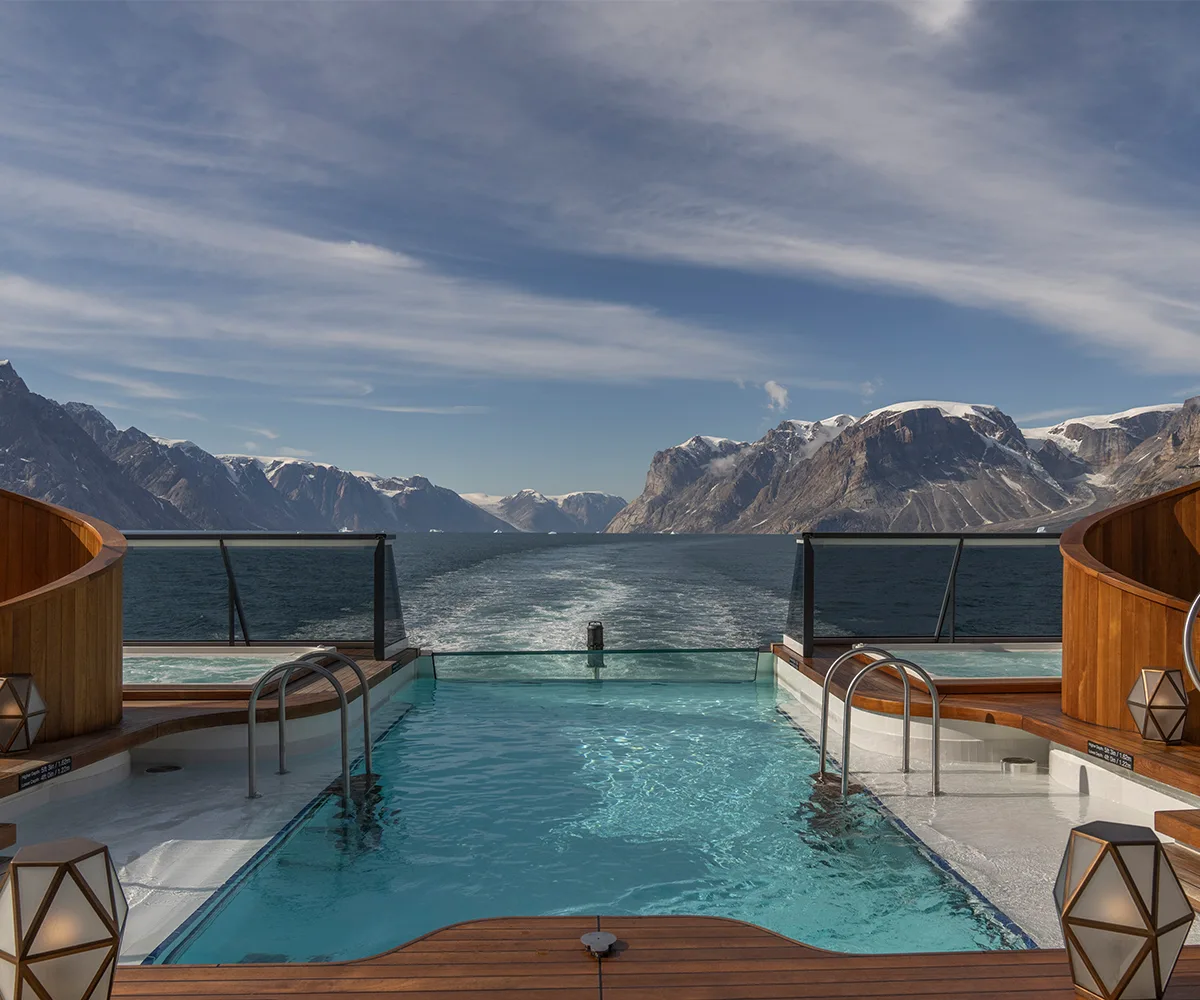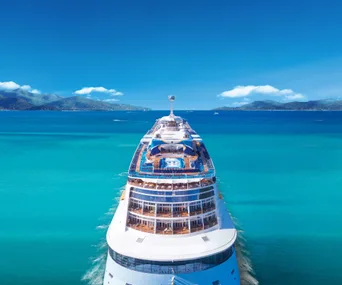It’s mid morning, and I’m in the middle of a bottle-green stretch of ocean called Karrat Fjord, an ice-rimmed inlet off the west coast of Greenland. The mercury sits at a significantly lower number than the time on the clock, chilling our breaths into visible clouds at around 3 degrees Celsius. But it’s September and this is considered a reasonably balmy day for the Arctic. I’m perched on the rubber edge of a Zodiac with nine other guests and a man who has completed 120 polar expeditions and piloted Zodiacs since 1977, Seabourn Venture expedition guide Peter Damisch. “Take a deep breath,” Damisch tells us all as he pulls up to the edge of a silent iceberg and quiets the boat’s engine to a low purr. We do. There’s a purity to the air. There’s something in it that tastes like a spearmint sweetness. “Now take another one,” he continues. “I really want you to breathe this place in because sometimes we fly from our homes to these beautiful remote places and we don’t see a darned thing.”
It’s exactly the right thing to tell us all close to the start of what turns out to be one of the most moving, and quietly contemplative sea voyages I’ve ever been on – a full traverse of the fabled Northwest Passage, from Greenland, sailing across roughly 4000 nautical miles of the remote Canadian Arctic to Nome, Alaska. Our journey traces the historic and often doomed European expeditions that attempted to cross this merciless stretch of Arctic wilderness from as early as British explorer Martin Frobisher in the 1500s (he barely made it to the edges) to the first successful voyage by the Norwegian Roald Amundsen in 1906. Incredibly, by the end of the 2022 crossing season (a full passage is only possible during the summer and early autumn months when the sea ice retreats), only 351 Western ships in history have ever made it through, though that’s increasing exponentially every year.
On this trip, around 180 passengers and 228 crew of Seabourn’s luxury expedition ship, the polar class Venture, will meet Inuit communities of the frozen north and be given generous insights to their way of life. We’ll see lonely graves on rocky shorelines, the only reminders left of catastrophic 19th-century European expeditions or isolated Canadian defence outposts. Over 21 days we’ll meet fogs and wind, wild seas and shimmering sunsets. Walrus, seabirds and polar bears. It’s not a trip for the weak of heart or constitution. Nor is it as easy as the Venture‘s floating luxury makes it seem – the trip is overseen by coastguards along the way and three ice pilots are on board to make sure we don’t go the same way as the many ill-fated expeditions before us. This is a journey of bold adventure. And it’s unforgettable, for anyone prepared to take a few of those long, quiet, thoughtful breaths.

The hot tub on the back deck of the ‘Venture’.
After leaving Greenland, most of the voyage’s early days are spent lowering our Zodiacs into the ocean to skirt dramatically barren coastlines: Dundas Harbour on Devon Island where several abandoned Royal Canadian Mountain Police huts are visible from the water, almost perfectly preserved thanks to the snap-freezing properties of the climate. On Philpots Island, I clamber to the top of a rocky outpost to watch a mother and calf walrus puff and plunge through the icy waters, snuffling beneath the waves for molluscs. At Beechey Island, we get our first up-close reminder of what it would have felt like to attempt this cruel crossing back when your only transport option was a flimsy wooden naval boat. At first our landing looks like it might not go ahead at all, as the Venture is surrounded by at least six polar bears stalking the shoreline at various positions visible through the binoculars provided in each of our suites: a mother with two cubs, a pair who look like siblings swatting playfully at each other in the shallows. But once we reach Beachey our scouting Zodiacs give the polar bear all-clear. We chug across the sea to the brown, silt-strewn shoreline and file a short way up a hill to view four lonely graves: three from the doomed Franklin expedition of 1845 in HMS Erebus and HMS Terror, and a fourth sailor from another of the many rescue expeditions sent to find the Franklin after it vanished in 1846. Peter Damisch is our guide again, and he seems quietly emotional as he recounts the few scraps known about the men’s final days: that they were visibly starving, wracked with lead poisoning from the cans used to transport their food. “It’s difficult to think about what this would have been like for these young Englishmen so far from home,” he says. We lower our cameras and lower our eyes.
It’s not all bleakness and poignant history lessons of course. This is Seabourn, a cruise line defined by its ultra-luxury amenities and service, even when picking its way through one of the most remote regions on earth. At Croker Bay, a fjord on the south coast of Devon Island, we launch our Zodiacs to look for wildlife to no avail, and instead our cruise director Brian Bailey appears on his own Zodiac to hand out glasses of Champagne to celebrate the fact we’ve reached the most northern stop on our journey. On board, the Venture feels like a cross between a ski lodge and a country club, and little Seabourn moments happen daily: on day one I’m presented with a choice of four different Molton Brown body washes to use during my voyage (Fiery Pink Pepper all the way, if you’re wondering), and I overhear one woman thanking a crew member for the fresh flowers in her suite. My across-the-hall neighbour Caroline, a delightful and adventurous woman in her eighties from Washington state, makes a standing date with me to order the ship’s extravagant caviar service every day at 5pm. It’s not the 19th century on the Venture, that’s abundantly clear.
Both crew and guests show respect and curiosity towards the Inuit communities, who, as our on-board Inuit guide, Mia Otokiak from Ikaluktutiak, or Cambridge Bay on Victoria Island explains, are “young and thriving” despite a hard history of displacement. Otokiak’s on-board lecture about Inuit culture and the truth of the horrors of colonisation is one of the best-attended on the voyage. When we arrive at her hometown, a tiny settlement of only 1700 people centred around a colourful musk ox sculpture made from salvaged metals, we visit the Canadian High Arctic Research Station where one of the centre’s guides, Jeannie Ehaloak, explains that Southern scientists studying everything from climate change to the Arctic are now mandated to include Inuit knowledge when they come to these regions to conduct experiments. “People have said for years, we’re tired of being researched. We want to be part of the research,” she says.

The Owner’s Suite aboard the ‘Venture’.
Afterwards, locals offer us plates of foods: mini caribou burgers, crackers draped with smoked Arctic char and pretty pink-green, lemony mountain sorrel. There’s also a toothpick of glistening, raw narwhal, a two-toned cube of charcoal grey and creamy white blubber. “It tastes best with soy sauce,” says someone. I try the oily lump both ways. I’m not sure the soy is a huge improvement.
In the final days of the voyage, the Arctic decides to make several grand gestures to remind us all that however impressive our modern-day ship might be, however far we’ve come with our depth sonars and high-speed engines and top-range cameras, nature is still in charge. On day 13, after days of nothing but bleak, rocky islands we zip our Zodiacs to Edinburgh Island in the Coronation Gulf in the Kitikmeot region of Nunavut. There, we have the almost impossible fortune to catch the tiny window of warmth that is the Arctic autumn. The hills are strewn with blueberries and Arctic cranberries and a bright yellow carpet of Arctic willow. It’s like returning to earth from Mars.
But our luck doesn’t last: a couple of days later my planned kayak trip to the eerily named Smoking Hills (so called because of brown coal beneath the surface that’s been burning spontaneously and continuously for centuries) is cancelled. It was the last chance to venture off the ship before Alaska. “We have the trifecta of danger: wind, swell and fog,” says the ship’s expedition leader, Fridrik Fridriksson. There’s an air of desultory disappointment for the next few sea days as we press on, blanketed in thick, pea-soup clouds. This, we agree among ourselves, is likely to be the underwhelming way our journey will end.
Not so fast. Just three days before we’re due to arrive in Nome, keen map watchers on board notice that Captain Simon Bishop has turned the Venture northwards and suddenly we’re surrounded by shimmering sea ice. Fat blobs of walruses huddle together on bobbing floes. A polar bear snoozes on a chunk of ice before standing and yawning and executing a few prancing jumps from floe to floe like a puppy. Flocks of glaucous gulls streak across the sorbet skies. Guests and crew crowd onto the broad bow with mouths open; we didn’t think we’d be seeing anything like this so late in the game. “Victory awaits him who has everything in order; some call it luck,” Northwest Passage hero Roald Amundsen famously said of the reason for his polar success. On this trip, there was plenty of great planning and a little sprinkle

The outdoor pool aboard the ‘Venture’.
Seabourn’s next Northwest Passage sailings will take place in August 2025. Bookings are open now and start from $49999 per person, twin-share, for an all-inclusive stay in a Veranda Suite. Plan your stay here.
Looking for a similar voyage? Check out Seabourn’s other journeys here.









